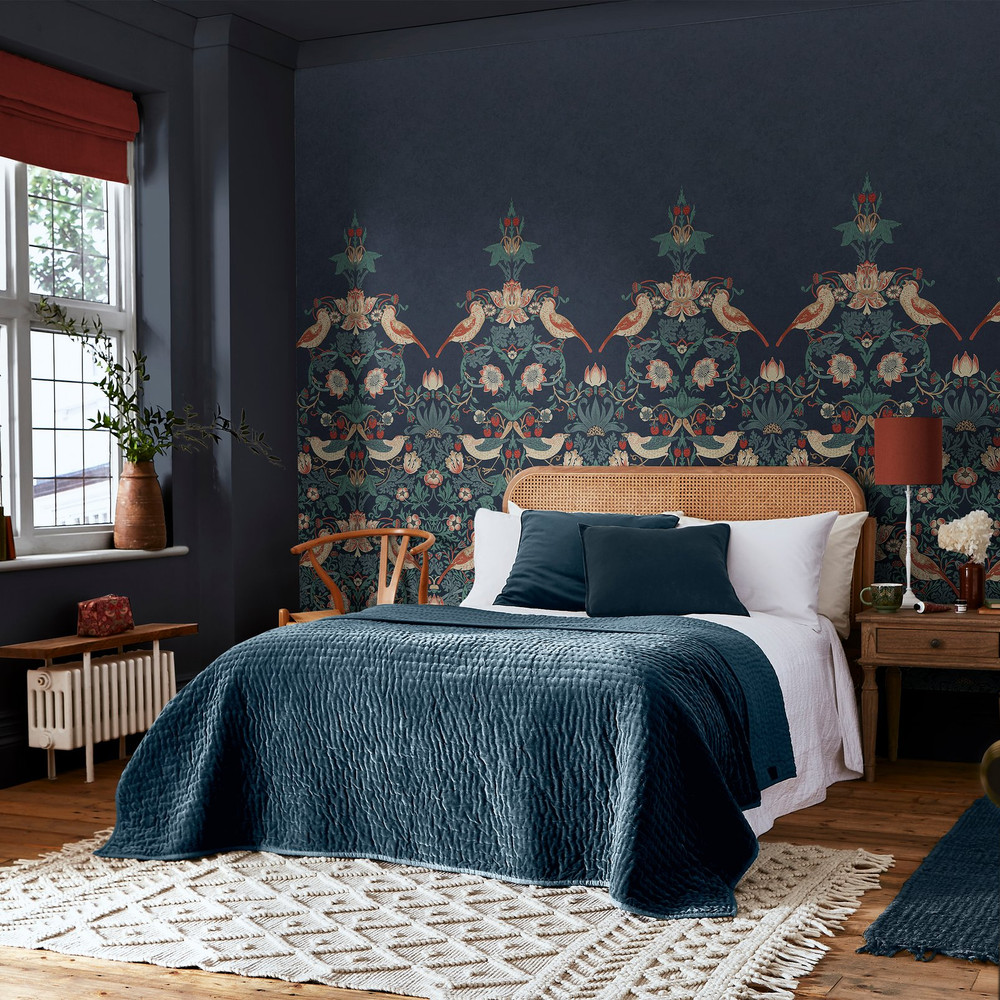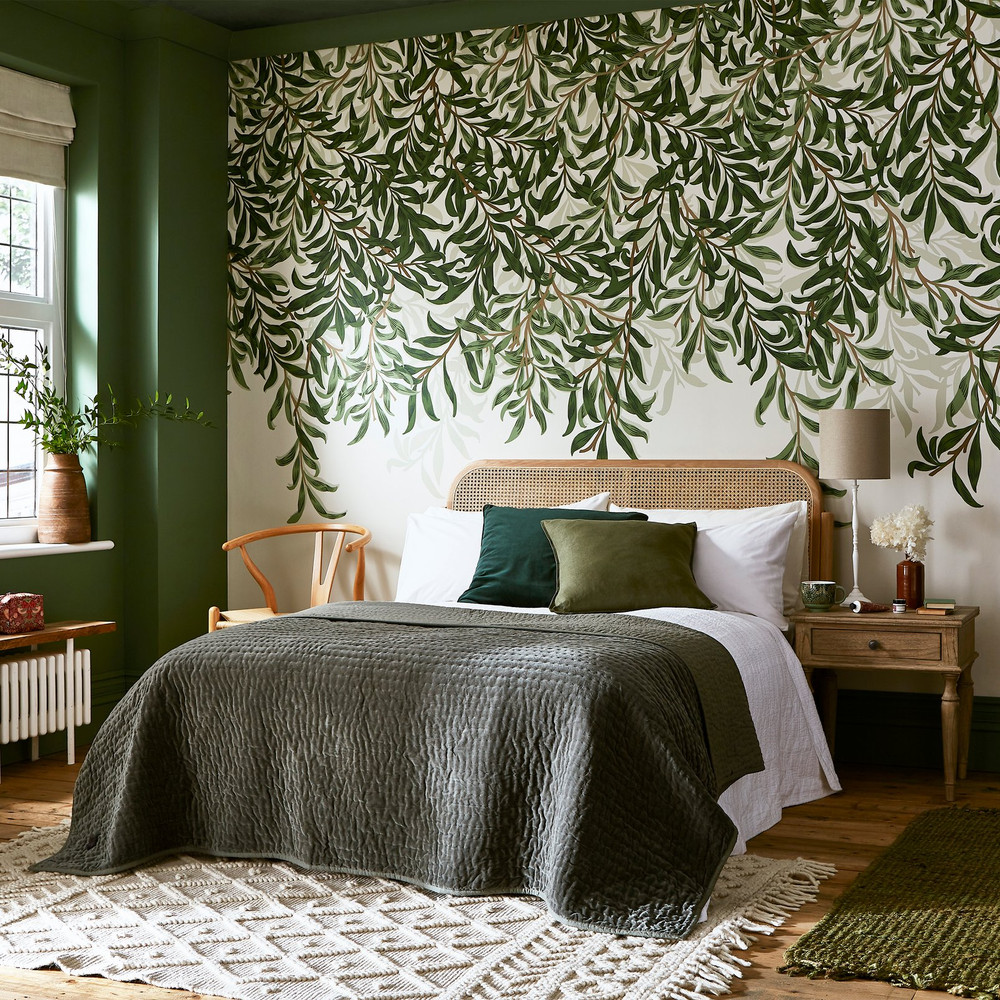What Wall Should Be a Feature Wall
A feature wall can instantly transform an average living room, a dull bedroom or even a bland bathroom. In this blog we will explore how to make the most of your focal point.

A feature wall can instantly transform an average living room, a dull bedroom or even a bland bathroom. Giving your décor a focal point lets you update your interior with depth and dimension. A feature wall can make a small space seem much larger, bring the outside in with floral and botanical designs, or add texture and vibrancy to a cold, unwelcoming north-facing room.
But which wall do you choose for maximum effect? And how do you get the most out of your signature look without overwhelming your space? Let's take a more in-depth look at what a feature wall is and how to position it so it truly has the wow factor as soon as you walk through the door.
And keep an eye out for some of our top tips on adding colour that harmonises with your feature wall to create a look straight out of a luxury interior design magazine!
What is a feature wall?
A feature wall forms the focal point of a room’s décor. It uses colour, patterns, texture, and contrast to add interest to a room, making a visual statement that influences how you decorate the rest of the space.
They can define an existing feature, such as an ornate fireplace, or add instant interest to a completely bland space. It can also express your own influences, your personality and your likes, whether you feel most at home surrounded by a forest full of trees or fields of wildflowers, or love the wide-open wonder of a mountain top.
The truth is that while there are techniques for creating the most compelling feature wall, there are very few rules regarding designs, colours, or patterns.
How do you pick the best wall for your feature wall?
There are some technical considerations to bear in mind when you’re planning your perfect feature wall.
The easiest way to start is to stand in the doorway leading into the room and take a long look. Ask yourself a few questions. Where is your eye drawn to straight away? What part of the room commands the most attention? Are there any walls that already have a feature that can be incorporated into the design?
Also consider different aspects of the room such as:
- Lighting – If there is an area that benefits from natural lighting, this will be the best place to position your feature wall to get maximum impact, such as opposite a window. If there is no natural lighting (for example, if your room is north-facing), consider how to arrange artificial lighting to give you the best illumination.
- Function – If you want to put a feature wall in a sitting room, do you want to see the wall, or do you want it to be behind you as a backdrop? The same thinking applies to a bedroom, where a feature wall is most often positioned behind the headboard of the bed to frame the sleeping area. This technique goes back centuries – if you look at beds in stately homes, you'll notice that large tapestries (the medieval equivalent of a feature wall!) are nearly always positioned behind the headboard.
- Ambience – What do you want to achieve with your feature wall? Is it a bright and fun addition to a nursery or a tranquil setting in a bedroom? The type of feature wall you create will have a big impact on the character of the room. So, for example, in a country cottage, a bold, 1960s-inspired Geo Pop mural may feel out of place, whereas a floral design or heritage pattern such as William Morris at Home or Laura Ashley would fit in well.

What won’t work
Remember that a signature wall is a focal point in a room. If you have to create it around a window or doorway, then you'll lose the visual impact. While existing features such as fireplaces may work within a carefully chosen pattern, the optimum is a 'blank canvas' wall with good natural lighting.
The 60-30-10 rule
An excellent guide to help you create a balanced décor is to follow the 60-30-10 rule. This states that 60% of your room should be your primary colour, although within that figure you can have variations of the same colour. A further 30% should be an accent colour that harmonises with the main colour. This can be anything from painting the skirting a different colour to the textiles and furnishings you use. The final 10% should be a coordinating colour, giving little pops of contrast around the room, such as a vase, accessories or artwork.
So, if we apply this rule to our feature wall scenario, the main colour will include the feature wall design and the accent walls. For example, if you choose a wall mural from our green murals range, your accent walls would be a variation of green (such as sage green or even teal).
Our top tip: When you’re choosing a mural or signature wallpaper from our collections, look for our perfect paint partner suggestions at the bottom of the page. These are paint colours carefully selected by our experts that effortlessly harmonise, balance, and coordinate with your mural or wallpaper.
Your 30% could be a further accent colour on the skirting and the curtains, while your 10% could be contrasting vases or paintings that still connect visually to your overall design.
Paint vs paper
A feature wall can be anything you want it to be. It can be a single block of colour or a textured wallpaper. It can be a striking wall mural or a showcase for a show-stopping piece of wall art. Most commonly, feature walls are either painted in a single colour, or utilise patterned wallpaper or a wallpaper mural. But if you're new to DIY, which will be easier to use to create that gorgeous, magazine-feature quality signature wall?
If you want a wall mural, it's easy to achieve a truly fabulous finish, thanks to Paste The Wall wallpaper and a bespoke service that creates your customised mural to your exact measurements. All you have to do is hang around five or six strips of wallpaper, and you can instantly transform your room.
Wallpaper signature walls are just as easy, again using Paste The Wall wallpaper and patterns that are easy to line up without too much waste or hassle.
And as for paints, well, there are literally thousands of colours for you to choose from!
So what are you waiting for? If your bedroom is boring and your living room lacklustre, brighten things up with a signature wall and love the space you live in every time you walk through the door!